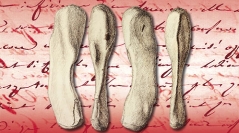

 Geodiversitas
45 (8) - Pages 243-276
Geodiversitas
45 (8) - Pages 243-276Charles Antoine Gaillardot (1774-1833), a former military doctor in the French army, who returned to his hometown of Lunéville (Meurthe-et-Moselle department, north-eastern France), was the first to report the presence of bones in the Upper Muschelkalk (Ladinian, Middle Triassic) of Rehainviller and Mont-sur-Meurthe (France). He communicated these specimens to Georges Cuvier (1769-1832) who described and illustrated them in the last volume of the new edition of his Recherches sur les ossemens fossiles published at the end of 1824. According to Cuvier, these bones were those of an unknown “saurian” exhibiting supposed affinities with crocodiles, ichthyosaurs, plesiosaurs and monitors (varans). Cuvier also thought he recognized the bones of a so-called “very large sea turtle”. A large part of this material, forgotten for two centuries, is still preserved in the collections of the Muséum national d’Histoire naturelle in Paris (MNHN) and is presented here for the first time since Cuvier’s publication. Unpublished drawings found in Cuvier’s archives kept at the central library of the MNHN also reveal specimens that he had mentioned without illustrating them. All this material represents the first sauropterygians discovered in the Triassic of France. Some of these specimens can notably be attributed to the nothosauroids (Nothosauroidea) Nothosaurus mirabilis Münster, 1834 and Simosaurus gaillardoti Meyer, 1842. Finally, the nomenclatural status of the many species introduced in the 19th century from this material is revised.
History of palaeontology, Eosauropterygia, Eusauropterygia, Nothosauroidea, Nothosaurus, Simosaurus, Triassic, Muschelkalk, Ladinian, Lorraine